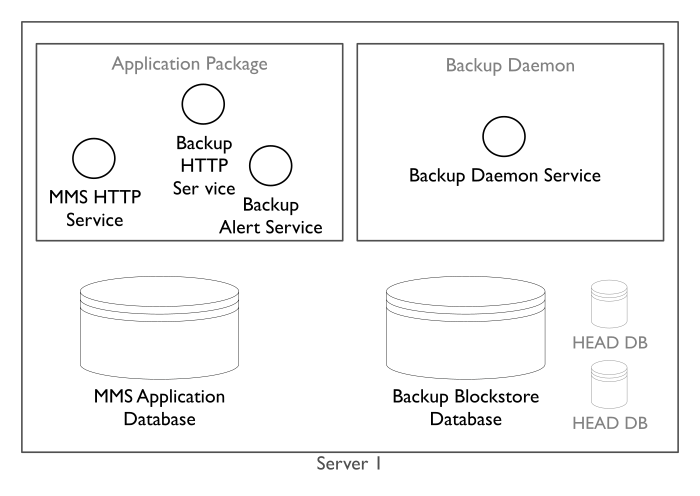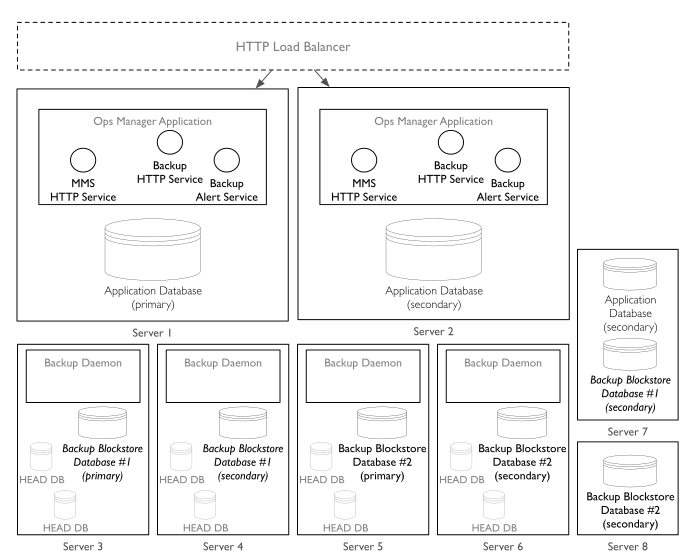- Install Ops Manager >
- Example Installation Diagrams
Example Installation Diagrams¶
On this page
Overview¶
The following diagrams show example Ops Manager deployments.
Non-Durable, Test Install on a Single Server¶
For a test deployment, you can deploy all of the Ops Manager components to a single server, as described in Install a Simple Test Ops Manager Installation. Ensure you configure the appropriate ulimits for the deployment.

The head databases are dynamically created and maintained
by the Backup Daemon. They reside on the disk partition specified
in the conf-daemon.properties file.
Durable Production Install¶
The basic deployment provides durability in case of failure by keeping a redundant copy of the application data and snapshots. However, the basic deployment does not provide high availability and cannot accept writes to the backing databases in the event that a replica set memeber is lost. See Durable, Highly Available Install with Multiple Backup Databases for a deployment that can continue to accept writes with the loss of a member.

Server 1 must satisfy the combined hardware and software requirements for the Ops Manager Application hardware and Ops Manager Application Database hardware.
Server 2 must satisfy the combined hardware and software
requirements for the Backup Daemon hardware and Backup Blockstore
database hardware. The Backup Daemon automatically creates and
maintains the head databases. These databases reside on the
disk partition specified in the conf-daemon.properties file.
Do not place the head databases on the same disk partition
as the Backup Blockstore database, as this will reduce Backup’s
performance.
Server 3 hosts replica set members for the Backup Blockstore and Ops Manager Application databases. Replica sets provide data redundancy and are strongly recommended, but are not required for Ops Manager. Server 3 must satisfy the combined hardware and software requirements for the Ops Manager Application database hardware and Backup Blockstore database hardware.
For an example tutorial on installing the minimally viable Ops Manager installation on RHEL 6+ or Amazon Linux, see Install a Basic Production Deployment on RHEL or Amazon Linux.
Durable, Highly Available Install with Multiple Backup Databases¶
The following is a highly available deployment that you can scale out to add additional Backup Databases.

The deployment includes two servers that host the Ops Manager Application and the Ops Manager Application Database, four servers that host two Backup deployments, and an additional server to host the arbiters for each replica set.
Deploy an HTTP Load Balancer to balance the HTTP traffic for the Ops Manager HTTP Service and Backup service. Ops Manager does not supply an HTTP Load Balancer: you must deploy and configure it yourself.
All of the software services need to be able to communicate with the Ops Manager Application databases, and the Backup Blockstore databases. Configure your firewalls to allow traffic between these servers on the appropriate ports.
Server 1 and Server 2 must satisfy the combined hardware and software requirements for the Ops Manager Application hardware and Ops Manager Application Database hardware.
Server 3, Server 4, Server 5, and Server 6 must satisfy the combined hardware and software requirements for the Backup Daemon hardware and Backup Database hardware.
The Backup Daemon creates and maintains the head databases. They reside on the disk partition specified in the
conf-daemon.propertiesfile. Only the Backup Daemon needs to communicate with the head databases. As such, theirnet.bindIpvalue is127.0.0.1to prevent external communication.net.bindIpspecifies the IP address that mongod and mongos listens to for connections coming from applications.For best performance, each Backup server should have 2 partitions. One for the Backup Blockstore database, and one for the head databases.
Server 7 and Server 8 host secondaries for the Ops Manager Application database, and for the two Backup Blockstore databases. They must satisfy the combined hardware and software requirements for the databases.
To deploy Ops Manager with high availability, see: Configure a Highly Available Ops Manager Application.